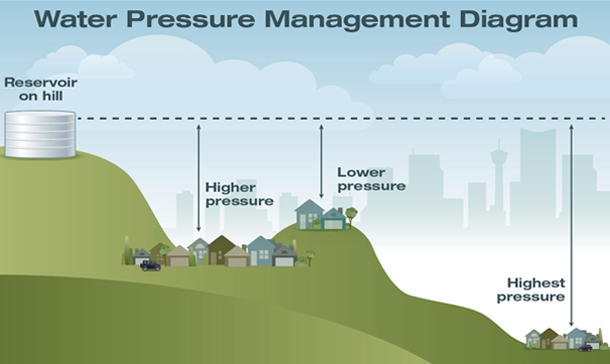Water pressure in Calgary
Troubleshooting water pressure problems
Check your taps
If you have lower pressure than expected, your faucet could be plugged with debris:
- Unscrew aerator from faucet and remove screen
- Soak screen in vinegar for 10-15 minutes
- If screen fizzles, then carbonate is present, which is a result of naturally occurring minerals in the water and is harmless
Check the main shut-off valve
Check the main shut-off valve to ensure it is fully opened.
The main shut-off valve is usually located either close to the water tank (in the basement, near the floor) or should be below the water meter where the main water line enters your home.
Check tap valves
Ensure the shutoff valves under your sinks are in full open position.
Check the pressure reducing valve
Homes built after 1990 in areas of over 80 PSI are equipped with a pressure reducing valve (PRV).
The PRV keeps the house plumbing from becoming over-pressured. High water pressure may be caused by a PRV that is over five years old and requires service.
Check water softener
If you have pressure issues with cold water and have a water softener, bypass the softener and see if pressure increases. If so, your water softener is the issue and a plumber will need to be called.
Check irrigation or sprinkler system
If you have an irrigation system that is active (for example: in the summer) check for leaks as this could be the cause of your pressure issue.
We suggest performing a "blow out" before winter to prevent sprinkler lines from bursting. During spring, it is common to experience low water pressure after turning back on the sprinkler system due to trapped air in the lines. Letting the line run for a while should improve the pressure.
Check for water maintenance work
Your water pressure may be temporarily affected by water maintenance work in your area. Look for a City notice or water crews working near your home Some examples of work that could affect water pressure are water main breaks or a fire hydrant being used.
Check for frozen water lines
In winter, if there is a gradual decrease in pressure, it could be a sign of frozen water lines. See our tips for dealing with Frozen Water Lines.
Problems with hot water pressure only
If you are experiencing issues with hot water only, please contact a plumber.
Questions about your drinking water?
For answers to other common drinking water questions like water hardness, and water taste, odour or appearance, visit Drinking Water in Calgary.
Further inquiries
If you have further inquiries about your water pressure, please call 311 or complete an online 311 request below.
Managing Calgary's water pressure
Calgary has an elevation range of almost 300 metres. This means we need to regulate pressure within our water system with a series of pressure zones.
The range of pressures in these different zones are created by the elevations of existing reservoirs and pump stations.
At elevations where pressure begins to exceed 70 metres (100 Psi), valves have been installed to keep the system from over-pressuring itself, as this can lead to water loss (leaks) and other issues.
The system is also designed to ensure adequate pressure throughout the city for fire protection, with pressure zones ensuring the Fire Department can pump a lot of water in a very short time if needed.



